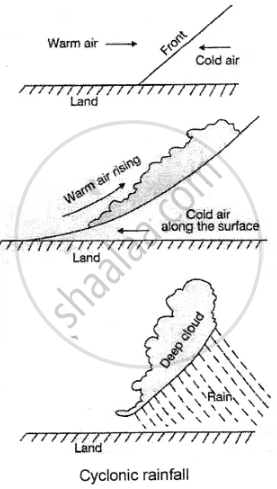Advertisements
Advertisements
प्रश्न
In your notebook, draw neat, labelled, coloured sketches of the three different types of rainfall. Alongside each diagram, briefly describe in your own words, how each type of rainfall occurs.
उत्तर
(a) Convectional Rainfall: In regions closer to the equator, the rate of evaporation is very high. Air gets heated because of the high temperature and starts rising in the form of convection currents. As it rises, it expands and cools. The cooling causes condensation, which results in heavy downpours. This rain is accompanied by thunder and lightning and since it mostly occurs around 4 p.m., it is often called the 4 o’clock showers’.

(b) Relief or Orographic Rainfall: Sometimes moisture-bearing winds are forced to rise because of the presence of a physical barrier, such as a mountain, in their path. Such winds expand and cool as they rise up the slope of the mountain or plateau, and on further cooling form clouds. When saturated, these clouds give rain

(c) Cyclonic or Frontal Rainfall - This type of rainfall occurs when warm and cold air masses meet and form a front. As cold air is denser, it remains close to the ground, while the warm air rises above it. As the warm air rises, it expands and cools, and the moisture in it condenses to form clouds. These clouds bring rainfall.

APPEARS IN
संबंधित प्रश्न
Write true or false. Correct the false statement.
The direction of wind blowing on the surface of the earth is affected by the Coriolis force.
Fill in the blanks
The temperature of a place depends upon its __________ ocean currents, _________.
Fill in the blank:
Planetary winds are also called permanent or _________winds.
Fill in the blank:
The amount of cloud cover in the sky is expressed in ________
Explain the different forms of condensation: fog, mist, and dew
What are the local winds? Give a few examples.
How are dewdrops beneficial for plants?
What is relative humidity? How does it differ from absolute humidity?
What is the weather report?
What are the elements of weather?
